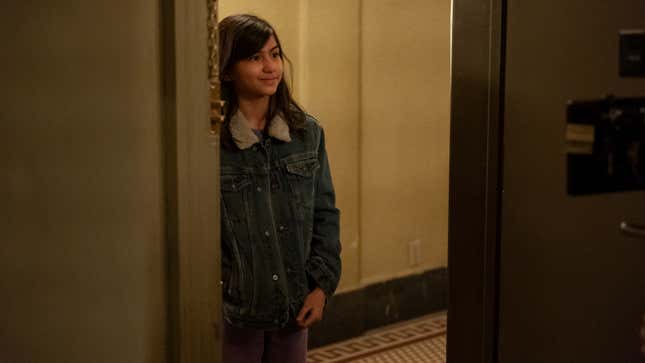
Let The Right One In, Showtime’s new crack at the Swedish vampire tale, brings to mind Bong Joon-ho’s 2020 Oscars acceptance speech. After winning Best Director and Best Picture for Parasite, the filmmaker took his audience to task. “Once you overcome the one-inch-tall barrier of subtitles,” he shared, “you will be introduced to so many more amazing films.”
In his speech, Bong points to Hollywood’s refusal to actually engage with seminal “foreign” cinema before mining it for marketable content. Parasite’s visually charged, performance-driven class satire rises far beyond that single inch, but the industry would rather jockey for the rights to an English-language adaptation than learn from an original. Unfortunately, it’s a trap Let The Right One In tumbles into early on.
Let The Right One In is the third onscreen adaptation of John Ajvide Lindqvist’s 2004 novel. An icy, masterful 2008 Swedish film is a certified cult classic, and a 2010 American update by Matt Reeves with Kodi Smit-McPhee and Chloe Grace Moretz proved deeply faithful to the original. In Showtime’s version, Eleanor (Madison Taylor Baez) is the pale protagonist who meets Isaiah (Ian Foreman) when she moves in next door at his apartment building with her father Mark (Demián Bichir). What Isaiah doesn’t know as he gleefully befriends “Eli” is that she’s a vampire who’s constantly on the run. What Eli doesn’t know is that Mark thinks he’s found her a cure and is about to re-recruit her godfather Zeke (a standout Kevin Carroll) to the cause.
If the 2010 American adaptation was unnecessary, Showtime’s is simply gratuitous. Much like the vampires it chronicles, Let The Right One In hungrily mauls its subject and loses the story’s meat in the process. In an attempt to build out a full-season arc, the series drowns its central characters in expositional dialogue and needless new plot devices.
The Swedish original was so mesmerizing in part because it refused to elucidate its morally ambiguous characters’ motivations or histories. Series creator Andrew Hinderaker takes the opposite approach here: While trying to dive into backstories, he flattens them. Once moody and traumatized, Isaiah’s character is now more of a chipper narc—believable traits for a seventh grader, but not so much for a vampire’s keeper. Anika Noni Rose is an unwavering highlight as Isaiah’s mother (and NYPD homicide detective) Naomi. But Rose could build better chemistry with Foreman if she didn’t have to keep putting on her Law & Order hat (while also almost singlehandedly shouldering a police violence storyline).
The pattern of thin depictions is exemplified in the new character Claire (Grace Gummer), a scientist summoned home by her pharma-wealthy father Arthur (Zeljko Ivanek) to care for her vampiric brother Peter (Jacob Buster). Claire hates Arthur because of a Sackler-style scandal inserted in an oddly overt manner. Although a somewhat satisfying mid-season reveal directly ties Claire’s storyline with Eli’s, it’s not enough to warrant six episodes of scattered exposition.
The stomach-churning bullying sequences in the Swedish film also aren’t as cutting here. The Showtime adaptation de-personalizes it all—Isaiah’s bullies are caricatures from a PSA, lobbing generic venom until thwarted (at one point, by the literal power of applause). Isaiah’s lack of interest in his own justice is also disappointing. He never gets to grow his own fangs, even proverbially.
Another unjustified choice is the move from suburbia to New York City. (The book and 2008 film are set in a Swedish hamlet, and the 2010 adaptation takes place in a New Mexico town.) Although there’s some logic—how unnoticed can multiple murders go somewhere so residential?—the plot suffers for it. In the original film, suburban ennui informs both the ceaseless cruelty Oskar experiences at the hands of his classmates and the drunkenly disillusioned adults around them. Without that context, the story is less haunting, and the tense scenes can lean comic-book in a bad way. (It is worth noting that Let The Right One In was filmed on-location, which at least brings a realistic grit to the new setting.)
One standout moment arrives in episode seven, which reveals how Eli became a vampire. The standalone episode may as well be a mirror to the series’ previous missteps. When Let The Right One In lets its characters be more than plot devices, it comes closer to justifying their existence. Fernanda Andrade is ethereal yet tenuous as Eli’s late mother, which makes the gruesome stakes of their relationship heartbreakingly believable.
As obnoxiously sincere as Eli is (case in point: trying to cook her former-chef father oatmeal while blasting “Special” by Lizzo), it explains her compatibility with Isaiah. (This is a preteen romance if ever there was one.) To her credit, Baez skillfully plays Eli as an only child who, even pre-vampire bite, spent her life shuffled among adults. The series works best when it toys with Mark and Eli’s dueling desires: Although each yearns for a new life, neither can relinquish the quest to reify a shared past.
In a time rife with ambitious (and more successful) horror adaptations, Let The Right One In just falls flat. As the series jumps between goofy romance, crime procedural, family drama, and horror, it loses all its narrative steam. And by eliminating suburban paranoia, dumbing down schoolyard cruelty, and centering cops, the series fails to capture the original’s tone.